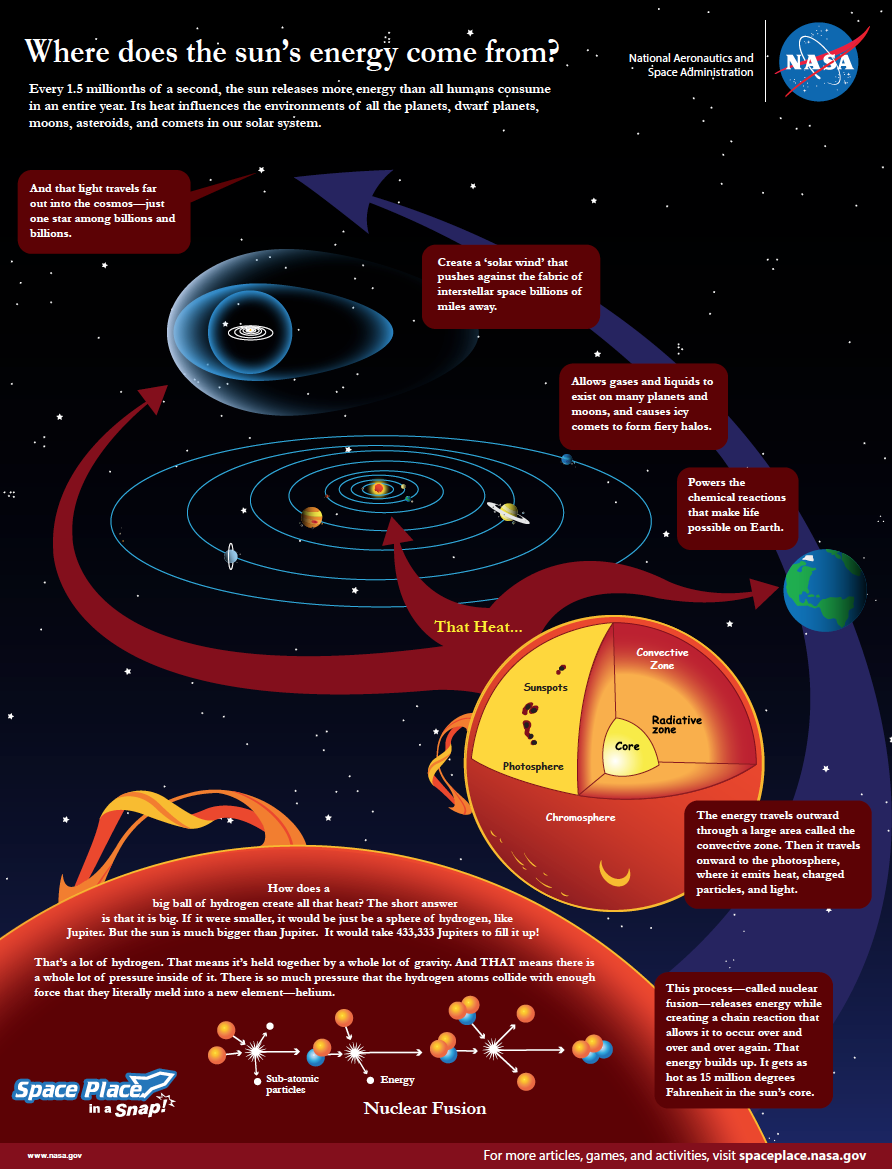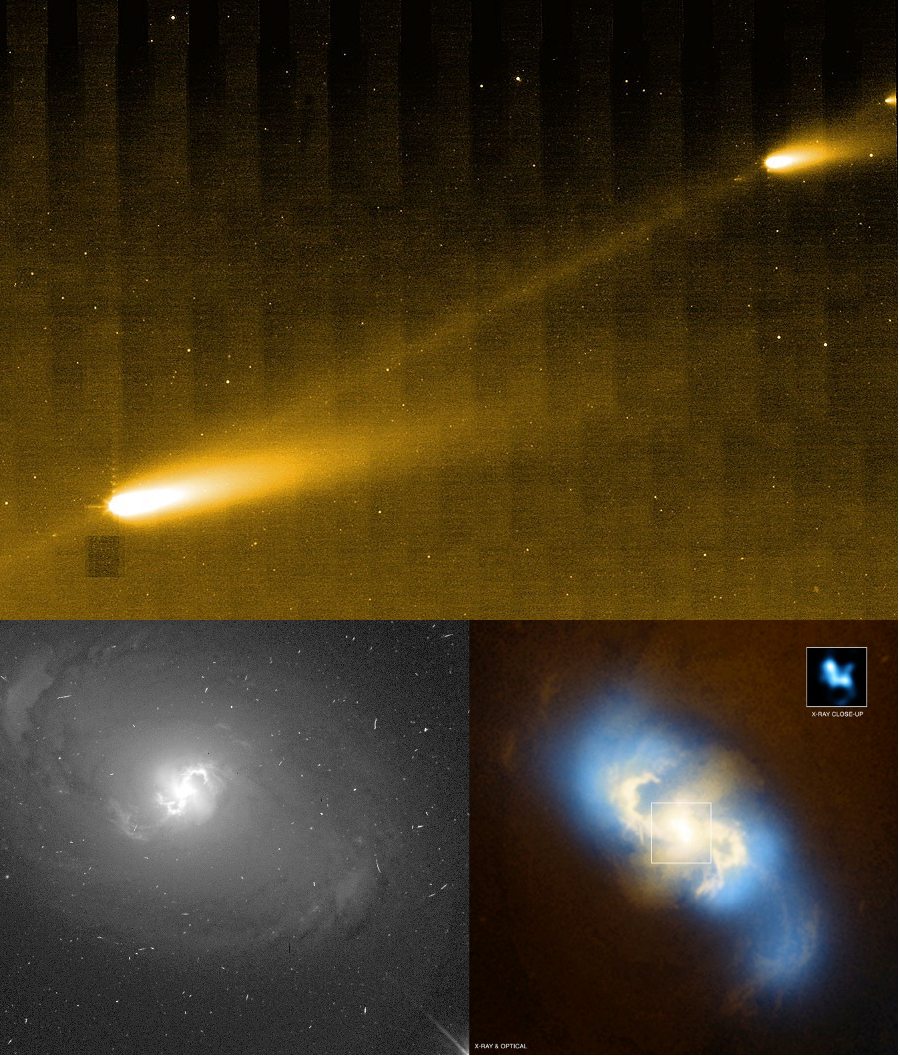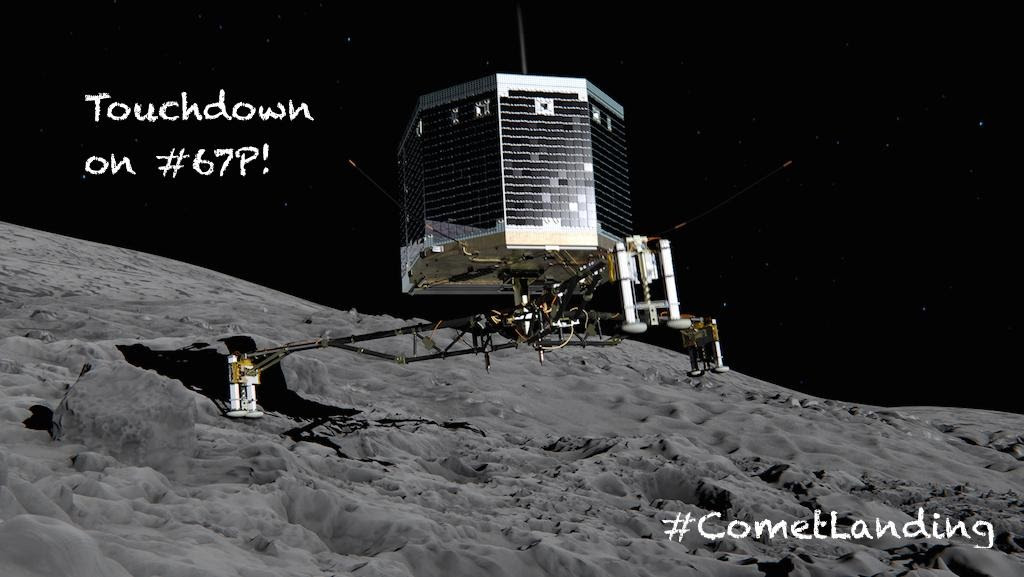Next Launch
Total Students
2,609
Total Launches
683
Eggs Survived
418 61.2%
Rockets Survived
536 78.5%
Oct. 1, 2014
Where Does the Sun's Energy Come From?
by Space Place in a Snap
Every 1.5 millionths of a second, the sun releases more energy than all humans consume in an entire year. Without the sun there would be no light, no warmth, and no life.
Its heat influences the environments of all the planets, dwarf planets, moons, asteroids, and comets in our solar system.
How does a big ball of hydrogen create all that heat? The short answer is that it is big. If it were smaller, it would be just be a sphere of hydrogen, like Jupiter.
But the sun is much bigger than Jupiter. It would take 433,333 Jupiters to fill it up!
That's a lot of hydrogen. That means it's held together by a whole lot of gravity. And THAT means there is a whole lot of pressure inside of it.
In fact, the pressure is so intense, and the density so great, that the hydrogen atoms collide with enough force that they literally meld into a new element - helium.
This process - called nuclear fusion - releases energy while creating a chain reaction that allows it to occur over and over and over again.
That energy builds up. It gets as hot as 15 million degrees Fahrenheit in the sun's core. The energy travels outward through a large area called the convective zone. Then it travels onward to the photosphere, where it emits heat, charged particles, and light.
That heat powers the chemical reactions that make life possible on Earth, allows gases and liquids to exist on many planets and moons, and causes icy comets to form fiery halos.
Those particles create a 'solar wind' that pushes against the fabric of interstellar space billions of miles away.
And that light travels far out into the cosmos - just one star among billions and billions.
Not too bad for a big ball of gas, no?
To see the video that goes along with this poster, visit: http://spaceplace.nasa.gov/sun-heat.
This article was provided by the Jet Propulsion Laboratory, California Institute of Technology, under a contract with the National Aeronautics and Space Administration.
 Where does the Sun's energy come from? Download the poster.
Where does the Sun's energy come from? Download the poster.
Oct. 1, 2014
3-D Gallery
by Nasa's Space Place
What's it like to be standing on the surface of Mars? What about floating outside a Space Shuttle or walking the surface of a massive asteroid?
Well, the Space Place can't take you to these places, but we've got the second best option - 3D images of them!
Pick up a pair of red-blue 3D glasses and take a look at our latest image gallery. It's got pictures from all around our solar system and from right here on Earth, too. http://spaceplace.nasa.gov/3d-gallery.
The Space Place is a NASA educational website about space and Earth sciences and technologies. It targets upper-elementary-aged-children.
This article was provided by the Jet Propulsion Laboratory, California Institute of Technology, under a contract with the National Aeronautics and Space Administration.
 Grab your 3-D glasses and explore the cosmos!
Grab your 3-D glasses and explore the cosmos!
Nov. 1, 2014
Where the Heavenliest of Showers Come From
by Dr. Ethan Siegel
You might think that, so long as Earth can successfully dodge the paths of rogue asteroids and comets that hurtle our way, it's going to be smooth, unimpeded sailing in our annual orbit around the sun. But the meteor showers that illuminate the night sky periodically throughout the year not only put on spectacular shows for us, they're direct evidence that interplanetary space isn't so empty after all!
When comets (or even asteroids) enter the inner solar system, they heat up, develop tails, and experience much larger tidal forces than they usually experience. Small pieces of the original object-often multiple kilometers in diameter-break off with each pass near the sun, continuing in an almost identical orbit, either slightly ahead-or-behind the object's main nucleus. While both the dust and ion tails are blown well off of the main orbit, the small pieces that break off are stretched, over time, into a diffuse ellipse following the same orbit as the comet or asteroid it arose from. And each time the Earth crosses the path of that orbit, the potential for a meteor shower is there, even after the parent comet or asteroid is completely gone!
This relationship was first uncovered by the British astronomer John Couch Adams, who found that the Leonid dust trail must have an orbital period of 33.25 years, and that the contemporaneously discovered comet Tempel-Tuttle shared its orbit. The most famous meteor showers in the night sky all have parent bodies identified with them, including the Lyrids (comet Thatcher), the Perseids (comet Swift-Tuttle), and what promises to be the best meteor shower of 2014: the Geminids (asteroid 3200 Phaethon). With an orbit of only 1.4 years, the Geminids have increased in strength since they first appeared in the mid-1800s, from only 10-to-20 meteors per hour up to more than 100 per hour at their peak today! Your best bet to catch the most is the night of December 13th, when they ought to be at maximum, before the Moon rises at about midnight.
The cometary (or asteroidal) dust density is always greatest around the parent body itself, so whenever it enters the inner solar system and the Earth passes near to it, there's a chance for a meteor storm, where observers at dark sky sites might see thousands of meteors an hour! The Leonids are well known for this, having presented spectacular shows in 1833, 1866, 1966 and a longer-period storm in the years 1998-2002. No meteor storms are anticipated for the immediate future, but the heavenliest of showers will continue to delight skywatchers for all the foreseeable years to come!
What?s the best way to see a meteor shower? Check out this article to find out: http://www.nasa.gov/jpl/asteroids/best-meteor-showers.
Kids can learn all about meteor showers at NASA?s Space Place: http://spaceplace.nasa.gov/meteor-shower.
This article was provided by the Jet Propulsion Laboratory, California Institute of Technology, under a contract with the National Aeronautics and Space Administration.
 Image credit: NASA / JPL-Caltech / W. Reach (SSC/Caltech), of Comet 73P/Schwassman-Wachmann 3, via NASA's Spitzer Space Telescope, 2006.
Image credit: NASA / JPL-Caltech / W. Reach (SSC/Caltech), of Comet 73P/Schwassman-Wachmann 3, via NASA's Spitzer Space Telescope, 2006.
Nov. 1, 2014
Rosetta's Lander Touches Down on a Comet!
by Nasa's Space Place and CNN
London (CNN) -- Imagination became reality Wednesday when a mechanical space traveler called the Philae probe plunked down on its target, a comet with a much less romantic name -- 67P -- some 310 million miles from Earth.
European Space Agency scientists and executives high-fived and hugged each other when the landing was confirmed. Spacecraft have crashed into comets before, but this is the first soft, or controlled landing, in history.
Later, ESA said there was a glitch.
After leaving the mother ship Rosetta and descending, Philae may have bounced, rather than gently settled, on the surface of the comet, ESA scientists said at a news conference. Comet 67P has a very weak gravity, so anchoring harpoons were designed to shoot into the comet to fix the spacecraft to the surface. They failed to fire and Philae is not firmly secure, ESA said.
"So maybe we didn't land once -- we landed twice," Philae lander manager Stephan Ulamec said. "Did we land in a soft sandbox or is there something else happening? We don't fully understand what happened."
Ulamec said scientists hope to know more on Thursday. In the meantime ESA isn't letting that problem ruin its big day.
'A place in the history books'
"Our ambitious Rosetta mission has secured a place in the history books: not only is it the first to rendezvous with and orbit a comet, but it is now also the first to deliver a lander to a comet's surface," Jean-Jacques Dordain, ESA's director general, said in an article posted on the ESA website.
Many people, and not just the ones who work for ESA, are excited about what kind of information Philae will deliver.
"Rosetta is trying to answer the very big questions about the history of our solar system," Matt Taylor, ESA Rosetta project scientist, said in the article on the ESA website. "What were the conditions like at its infancy and how did it evolve? What role did comets play in this evolution? How do comets work?" And science fiction writer Alastair Reynolds said: "This is science fiction made real in terms of the achievement of the mission itself, but Rosetta is also taking us a step closer to answering science fiction's grandest question of all: Are we alone?"
Rosetta took off from Earth 10 years ago carrying Philae and traveled 6.4 billion miles before arriving in early August at the comet.
The Philae lander separated from the orbiting Rosetta around 3:30 a.m. ET Wednesday and landed on the comet seven hours later.
ESA lander system engineer Laurence O'Rourke told CNN that the orbiter Rosetta had to be in the right position to allow the lander craft, which had no thrusters, to "free fall" on the correct trajectory so it landed on the comet. The lander weighs about 220 pounds and is the size of a domestic washing machine. The target comet is only four kilometers, or 2.5 miles, in diameter.
Named after Rosetta Stone
Shortly after landing was confirmed, the probe tweeted: "Touchdown! My new address: 67P!" Later, it tweeted again: "I'm on the surface but my harpoons did not fire."
What can we learn from comet landing
The mission has historic allusions.
The spaceship is named after the Rosetta Stone, an inscribed piece of volcanic rock found in Egypt in 1799 that allowed scientists to decipher hieroglyphics and thus understand the ancient Egyptian culture, ESA said. The lander is named after an island in the Nile River where an obelisk was found that helped decipher the Rosetta Stone, ESA said.
Led by ESA with a consortium of partners including NASA, scientists on the Rosetta comet-chasing mission hope to learn more about the composition of comets and how they interact with the solar wind: high energy particles blasted into space by the sun.
The comet is currently 500 million kilometers (310 million miles) from Earth and pictures from the Rosetta mission to track it on its orbit around the sun have amazed scientists.
An array of experiments
We can land on a comet, but we can't...
Philae is equipped with an array of experiments to photograph and test the surface of Comet 67P as well as to find out what happens when the roasting effect of the sun drives off gas and dust.
Built by a European consortium, led by the German Aerospace Research Institute, the landing probe has nine experiments.
According to details on ESA's Rosetta website, sensors on the lander will measure the density and thermal properties of the surface, gas analyzers will help detect and identify any complex organic chemicals that might be present, while other tests will measure the magnetic field and interaction between the comet and solar wind.
What is a comet and what will Rosetta discover?
Philae also carries a drill that can drive 20 centimeters (8 inches) into the comet and deliver material to its onboard ovens for testing.
Scientists are already pleased with progress of the mission, and they're wowed by what's already been accomplished.
ESA project scientist Matt Taylor said: "The orbiter will remain alongside the comet for over a year, watching it grow in activity as it approaches the sun, getting to within 180 million kilometers (112 million miles) in summer next year, when the comet will be expelling hundreds of kilograms of material every second." Daniel Brown, an astronomy expert at Nottingham Trent University in the United Kingdom, said: "Apart from the amazing scientific results, the sheer challenge and ambition of such a mission is outstanding and illustrates how our space exploration of the solar system has become more advanced and successful. It gives us much to hope for in future missions."
"It's got an awesome profile -- the adventure of the decade-long journey necessary to capture its prey, flying past the Earth, Mars and two asteroids on the way," NASA's chief scientist, Ellen Stofan, told CNN: "No one has ever gotten data like Rosetta has gotten. No one has ever been able to land on a comet the way Philae just did."
How comet mission helps search for alien life
You can follow the lander in its quest for information about the comet on http://www.nasa.gov/rosetta/
You can also simulate the mission by playing Comet Quest. The game is available on line at http://spaceplace.nasa.gov/comet-quest/ and in the Apple apps store for the mobile version.
This article was provided by the Jet Propulsion Laboratory, California Institute of Technology, under a contract with the National Aeronautics and Space Administration and CNN.
 Touchdown on 67P
Touchdown on 67P